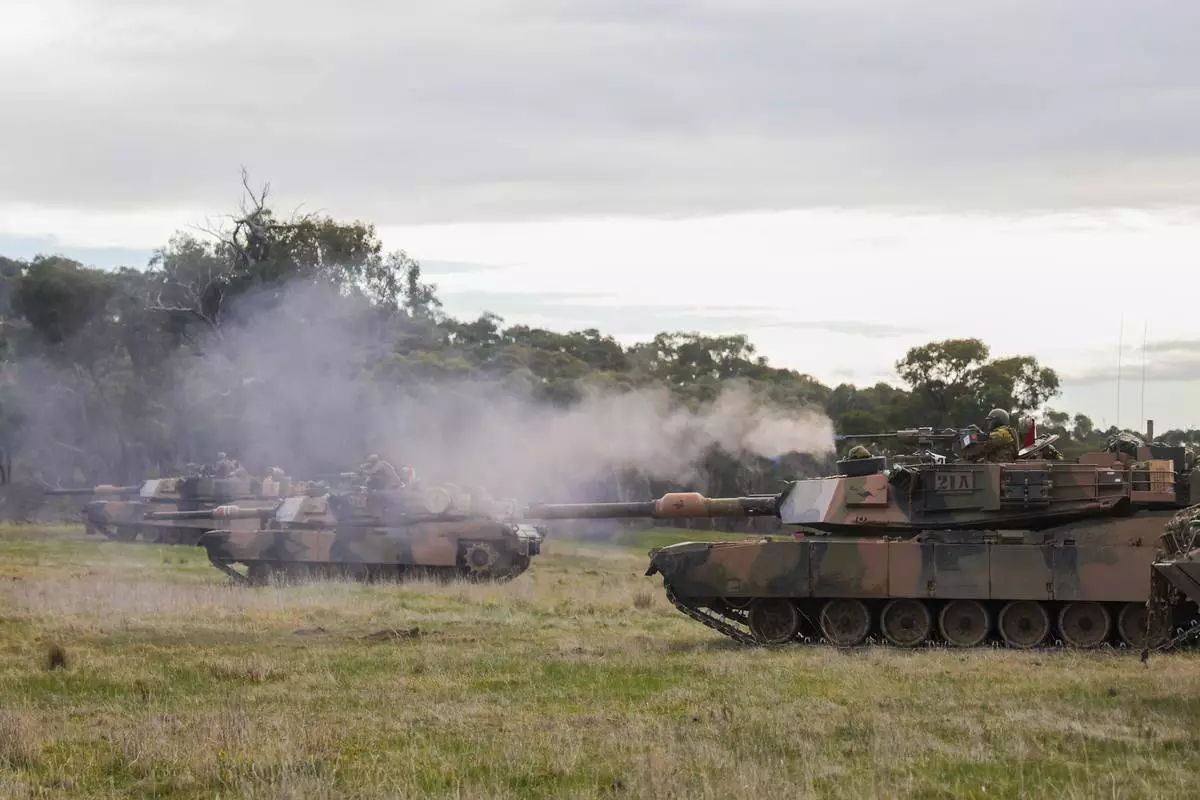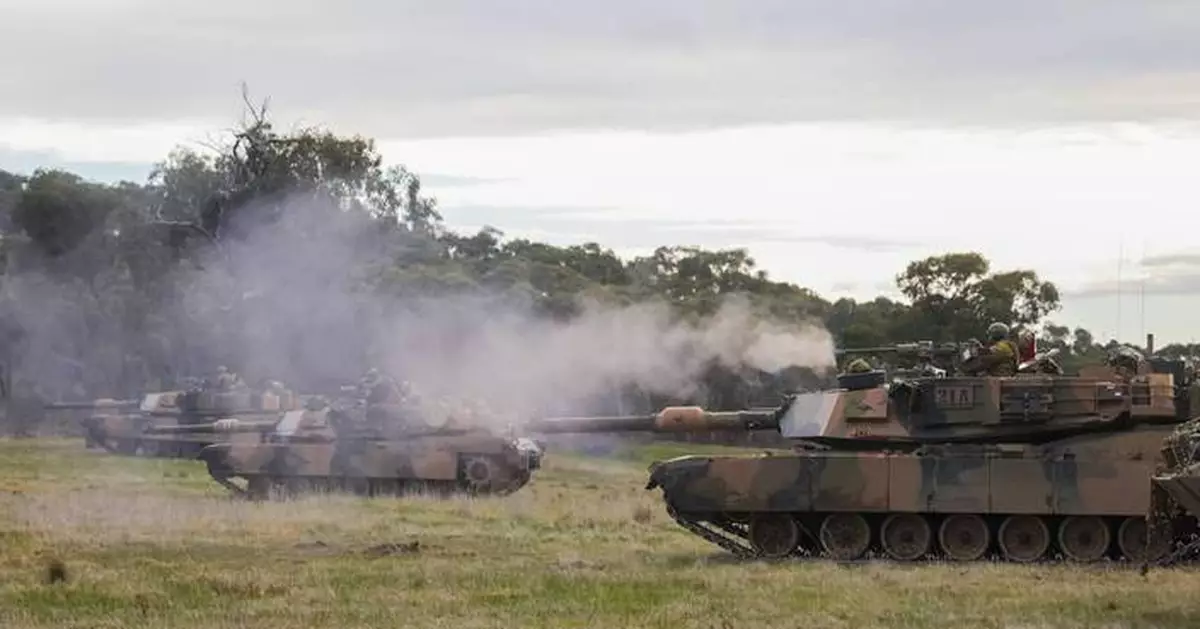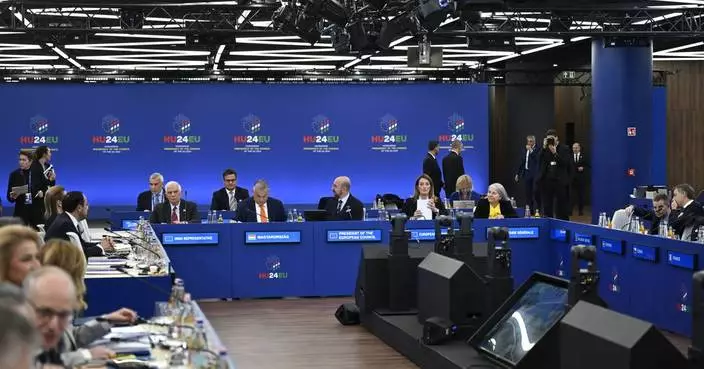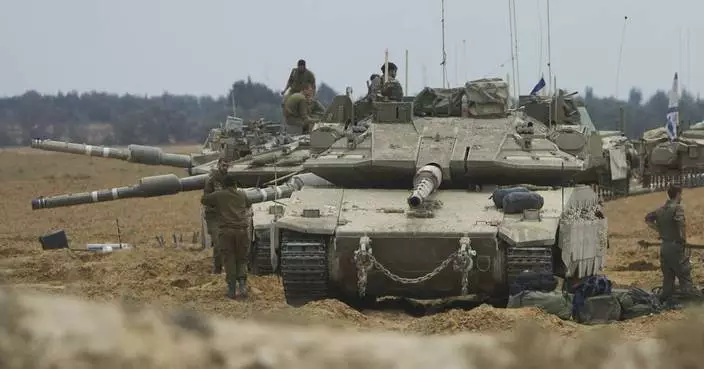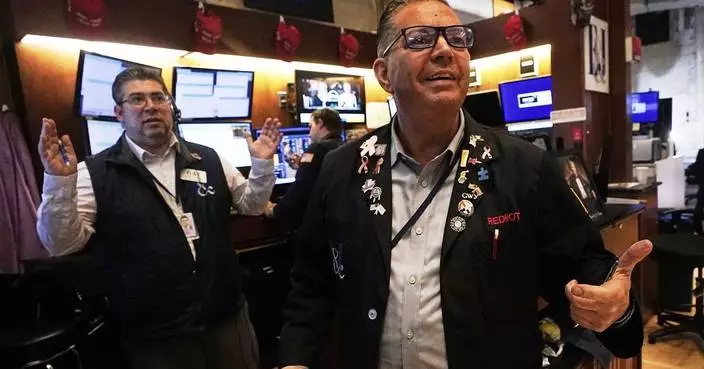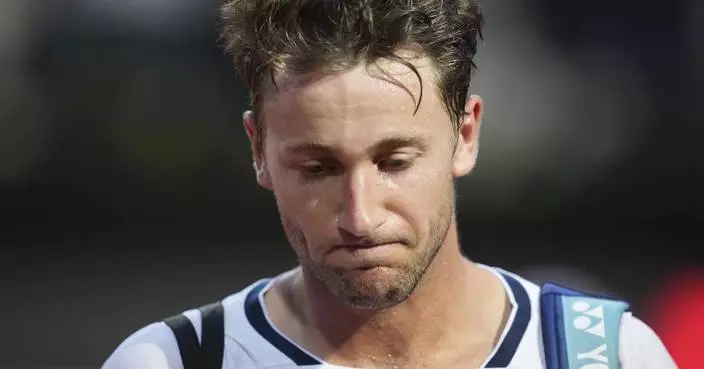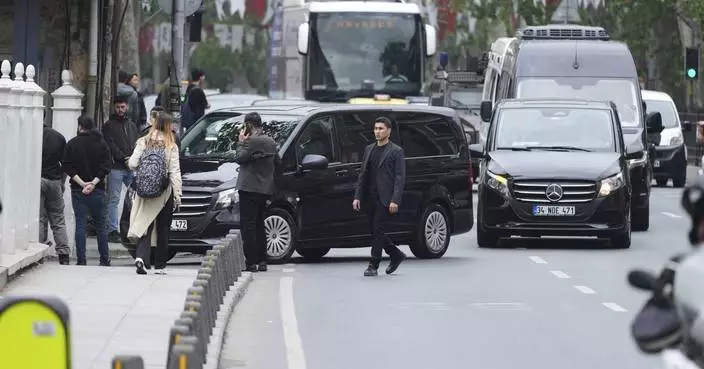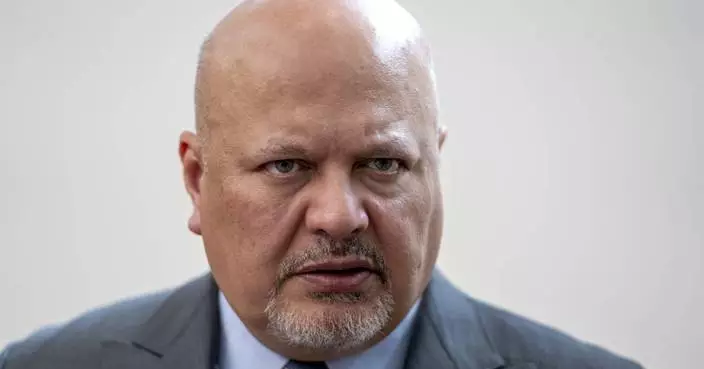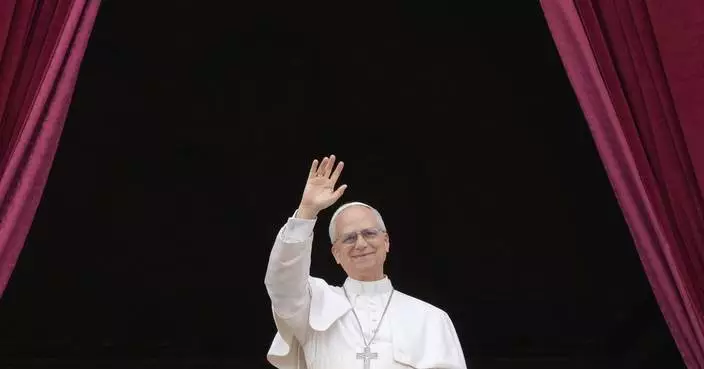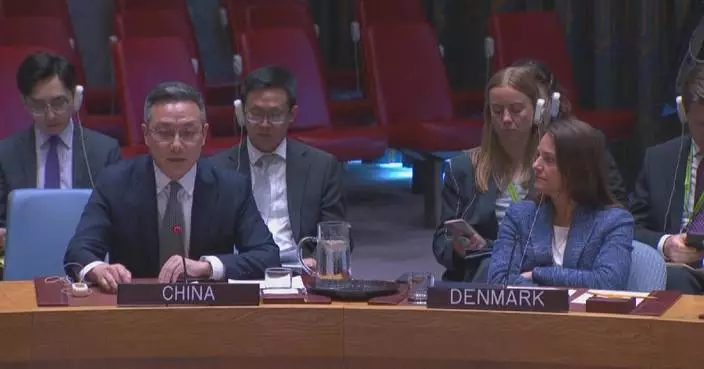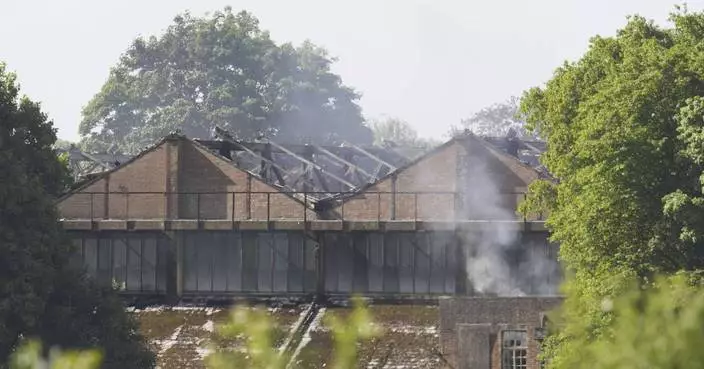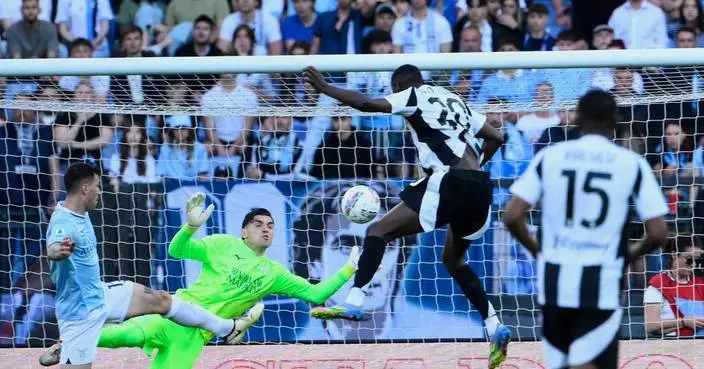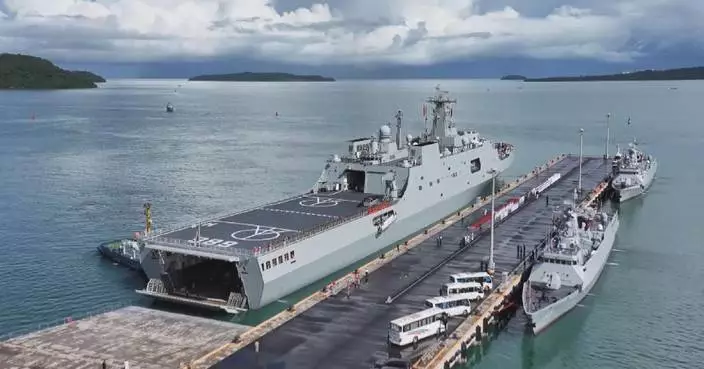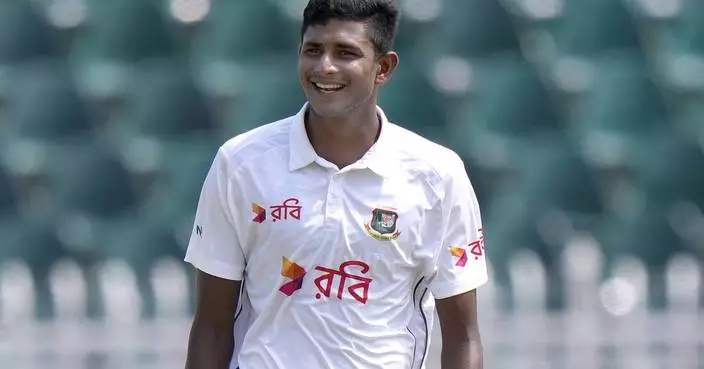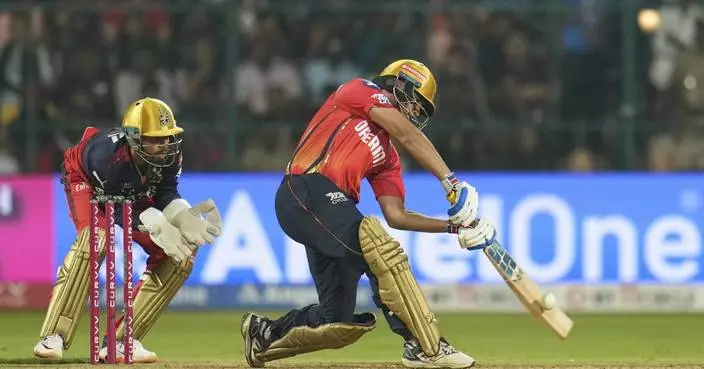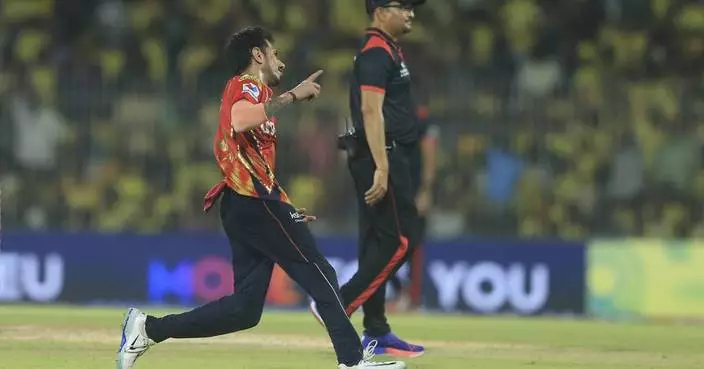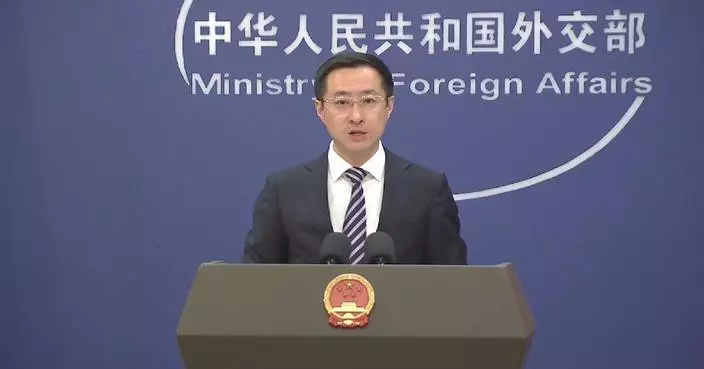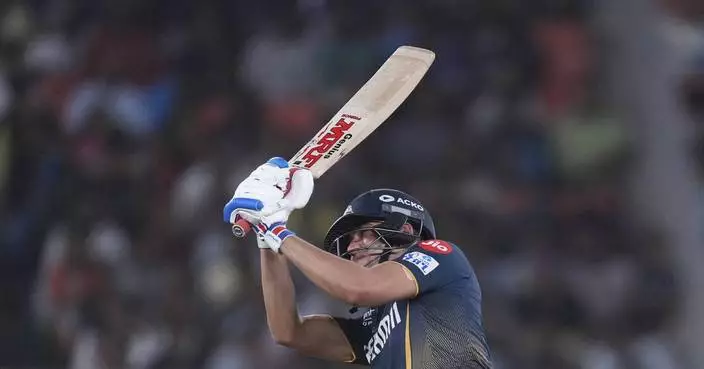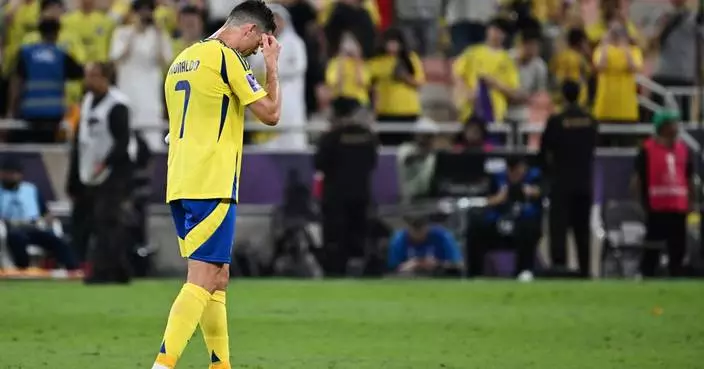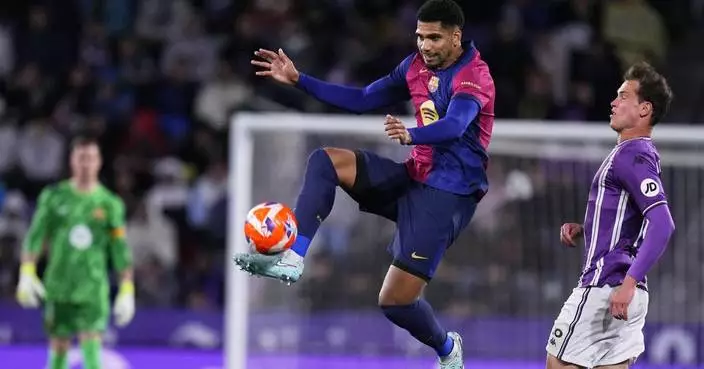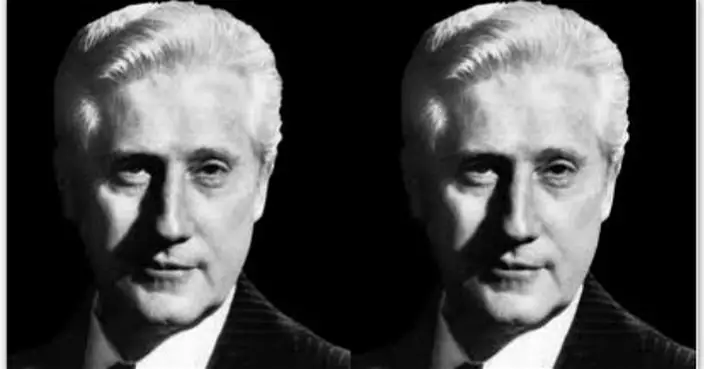President Donald Trump President Donald Trump on Friday wrapped up a Mideast tour in the United Arab Emirates with a breakfast for business leaders and a visit to an interfaith place of worship named for the Abraham Accords he negotiated.
As part of the accords, the UAE and some other countries in the Middle East recognized Israel. Trump departed Abu Dhabi after his visit to the Abrahamic Family House .
During his visit to the region, violence flared in the West Bank and Gaza. Israeli strikes killed at least 93 people Friday, adding to the more than 120 people who died in recent days.
Here's the latest:
Israel’s military said Friday it struck two ports in Yemen that were controlled by the Houthi militant group.
It claimed that the Hodeida and Salif ports were used by the Houthis to transfer weapons.
There were no immediate reports of casualties.
As President Trump jetted from one sprawling palace to another, embracing Arab leaders and heralding a new Middle East this week, many in Israel worried that the best partner they’ve ever had in the White House had lost interest.
For decades, Israel has leveraged its special relationship with the United States to serve as a gatekeeper to Washington. From the Camp David Treaty with Egypt to the Abraham Accords brokered by Trump in his first term, Arab states seeking U.S. favor usually had to first make nice with Israel. And rarely did their interests prevail if they clashed with Israel’s.
But on Wednesday, to Israel’s dismay, Saudi Arabia and Turkey brokered a historic meeting between Trump and Syria’s new president, and Trump portrayed his decision to lift sanctions on Damascus as a favor to his host, Saudi Crown Prince Mohammed bin Salman, and Turkish President Recep Tayyip Erdogan.
▶ Read more about Israel and the Middle East
During a recent concert in Manchester, England, Springsteen said the United States was “currently in the hands of a corrupt, incompetent and treasonous administration.”
“Never liked him, never liked his music, or his Radical Left Politics,” Trump wrote on Truth Social. He said Springsteen “ought to KEEP HIS MOUTH SHUT until he gets back into the Country, that’s just ‘standard fare.’ Then we’ll all see how it goes for him!”
Trump also targeted Swift, seemingly unprompted.
“Has anyone noticed that, since I said ‘I HATE TAYLOR SWIFT,’ she’s no longer ‘HOT?’” he wrote.
Trump originally attacked Swift shortly after she endorsed then-Vice President Kamala Harris in last year’s presidential election.
Edan Alexander, the Israeli-American hostage released Monday after backdoor US-Hamas diplomacy, left the hospital Friday, according to a statement released by his parents, who said his recovery is far from over.
Yael and Adi Alexander said their son still needed medical treatment for his injuries suffered during the Hamas attack Oct. 7, 2023, and over his 18 months in captivity. His hands are injured from a tunnel collapsing on him, they said.
Alexander returned to his grandmother’s home in Tel Aviv, where his parents said he will stay for the time being.
“Today we were able to take down Edan’s hostage photos from the wall with a great sigh of relief and an enormous sense of comfort,” they said, calling for the return of 58 hostages still in Gaza.
Joe Biden’s time in public office is now behind him, but his age and mental acuity have become a litmus test for the next leaders in his party.
A new book that alleges White House aides covered up Biden’s physical and mental decline has put the questions about Biden’s health back in the spotlight, months after former Vice President Kamala Harris lost to Trump. Several potential Democratic contenders for the 2028 nomination in recent days have been asked whether they believe Biden was declining in office or whether he should have sought reelection before a disastrous debate performance led to his withdrawal.
Many Democrats would prefer to focus on Trump’s second term. Trump has done his best to prevent that — mentioning Biden’s name an average of six times a day during his first 100 days in office, according to an NBC News analysis — and Republicans have followed his lead, betting that voters frustrated by Trump’s policy moves will still prefer him over memories of an unpopular presidency.
▶ Read more about the Democrats and former President Joe Biden
And they intend to coordinate a response, U.K. Prime Minister Keir Starmer said Friday.
“We just had a meeting with President Zelensky and then a phone call with President Trump to discuss the developments in the negotiations today, and the Russian position is clearly unacceptable,” Starmer told reporters.
“As a result of that meeting with President Zelensky, under discussion with President Trump, we are now closely aligning and coordinating our responses and will continue to do so,” he said, as European leaders held a summit in Albania.
He said the decision with Trump was also agreed on with the leaders of France, Germany and Poland.
▶ Read more about the European summit in Albania
Speaking to Bret Baeir during his Middle East trip, Trump criticized the former FBI director for posting a picture of shells that said “86 47.”
“He knew exactly what that meant,” Trump said, according to interview excerpts released Friday. “A child knows what that meant. If you’re the FBI director and you don’t know what that meant, that meant assassination.”
Trump is the 47th president. The number “86” means “to throw out,” “to get rid of” or “to refuse service to,” according to Merriam-Webster, the dictionary used by The Associated Press.
Comey apologized for the post and denied it was a call for violence.
Trump didn’t say what should happen next with Comey, saying “I don’t want to take a position on it” and the matter was up to his staff. However, he described him as a “dirty cop.”
“And if he had a clean history, I could understand if there was a leniency, but I’m going to let them make that decision,” he said.
The Secret Service is investigating, according to Homeland Security Secretary Kristi Noem.
Trump made his name by playing a demanding boss on “The Apprentice,” and he still likes to give his staff a hard time.
Commerce Secretary Howard Lutnick told Fox News about the president hovering behind him while he signed an agreement with the United Arab Emirates on Thursday.
“‘This better be a good deal, Howard,’” Lutnick recalled Trump saying. “And then he leans close, he goes, ‘Or your ass is grass.’”
At least 93 people were killed by Israeli strikes in Gaza on Friday, as President Trump wrapped up his regional trip.
Strikes overnight hit across Gaza, including the outskirts of Deir al-Balah and the city of Khan Younis. Gaza’s health ministry said hundreds more were injured in addition to those killed.
The widespread attacks across come as Trump finishes his visit to Gulf states but not Israel. There had been widespread hope that his regional trip could usher in a ceasefire deal or renewal of humanitarian aid to Gaza. An Israeli blockade of the territory is now in its third month.
The force, known as UNIFIL, said one of its patrols was confronted between the villages of Jmayjmeh and Khirbet Selm Friday by a large group of people in civilian clothing who “attempted to stop the patrol using aggressive means, wielding metal sticks and axes, resulting in damage to the vehicles.”
The peacekeepers used “non-lethal force” in response, and there were no injuries, it said in a statement.
Hezbollah supporters in Lebanon frequently accuse the U.N. mission — which was created to oversee the withdrawal of Israeli troops from southern Lebanon after Israel’s 1978 invasion -- of collusion with Israel. Israel has accused the peacekeepers of turning a blind eye to Hezbollah’s military activities in southern Lebanon.
Earlier this week, UNIFIL issued a statement that complained of “aggressive behavior” by Israeli forces towards its peacekeepers, including shots fired across the border that hit a UNIFIL base south of the village of Kfar Shouba.
Strikes overnight and into Friday hit across Gaza, including the outskirts of Deir al-Balah and the city of Khan Younis. At least 66 people were killed according to the Indonesian hospital, where most of the bodies were taken. A further 16 bodies were taken to Nasser hospital, said health officials.
The widespread attacks across northern Gaza come as Trump finishes his visit to Gulf states but not Israel.
Speaking to reporters aboard Air Force One before take off, the president said the U.S. has given Iran a proposed agreement.
It was the first public acknowledgement of a significant development in the high-stakes negotiations over Tehran’s nuclear program.
“They have a proposal,” Trump said. “But most importantly, they know they have to move quickly, or something bad is going to happen.”
He did not give specifics.
The protesters expressed support for Daniel Yahalom, a reserve soldier who is serving five days in prison for refusing to participate in what he called an unjust fight.
He’s part of a small but growing number of Israelis who are refusing to show up for service as the war drags on and Israel intensifies its operations in Gaza.
The Israeli military confirmed Yahalom was going to prison and said he was not the first to receive a prison sentence for refusing to serve during the current Israel-Hamas war.
“This boy always cares about others even before himself ... He cares about the suffering of our brothers who are dying underground, and he is willing to pay the price,” said his mother Haya Yahalom.
President Donald Trump has boarded Air Force One in Abu Dhabi as he ends his Mideast trip.
Sheikh Mohammed bin Zayed Al Nahyan, Abu Dhabi’s ruler and the leader of the United Arab Emirates, met Trump at the airport. The men shook hands and spoke for a few moments.
Trump also said goodbye to other officials. He looked back, saluted and pumped his fist in the air before boarding the aircraft to head back to Washington.
President Donald Trump has said “a lot of people are starving” in Gaza, a rare acknowledgement of the humanitarian crisis in the territory as Israel’s war with Hamas is on the verge of escalating anew.
Speaking to reporters at a business forum in Abu Dhabi on the final day of his trip to the Middle East, Trump said he was looking to resolve a range of global crises.
“We’re looking at Gaza,” he said. “And we’ve got to get that taken care of. A lot of people are starving ... There’s a lot of bad things going on.”
At least 48 bodies were brought to the Indonesian hospital and another 16 bodies were taken to Nasser Hospital, health officials in Gaza said, as strikes overnight into Friday morning hit the outskirts of Deir al-Balah and the city of Khan Younis.
The strikes came as U.S. President Donald Trump wraps up his Middle East visit that skipped Israel and offered no prospect for a ceasefire in the war-battered territory.
There had been widespread hope that Trump’s regional trip could usher in a ceasefire deal or renewal of humanitarian aid to Gaza. An Israeli blockade of the territory is now in its third month.
An Israeli official said the strikes on Friday were preparatory actions in the leadup to a larger operation and meant to send a message to Hamas that it will begin soon if there isn’t an agreement to release hostages. The official was not authorized to brief media and spoke on condition of anonymity.
— Tia Goldenberg in Tel Aviv, Israel
The interfaith complex in Abu Dhabi features a mosque, church and synagogue — houses of worship for the three Abrahamic faiths.
It was built after the United Arab Emirates signed onto the Abraham Accords in 2020, during President Donald Trump’s first term. The agreement –- which Trump has encouraged other Middle Eastern and North African countries to join –- saw the UAE recognize Israel.
The visit to the white-marble place of worship on the shores of the Persian Gulf is set to conclude Trump’s first major foreign trip of his second term.
“I think it’s time for us to just do it,” Trump told reporters in Abu Dhabi.
Trump reiterated that he wasn’t surprised that Putin skipped a U.S. orchestrated meeting in Turkey between Ukrainian and Russian officials. Putin didn’t want to go because he’s not there, Trump said.
Trump added that a meeting with Putin would happen “as soon as we can set it up.”
“ I would actually leave here and go,” said Trump, who noted his daughter Tiffany just gave birth to her first child. “I do want to see my beautiful grandson.”
Trump says he’s had an “incredible” trip to the Middle East but that “now it’s time to go back home.” He added: “My daughter had a baby and I’m going to go home and see that baby.”
Tiffany Trump gave birth to a boy.
“She’s doing great and the baby’s great.”
An Israeli official said Cabinet members are meeting Friday to assess the negotiations in Qatar and to decide on next steps. The official was not authorized to brief media on the meeting and so spoke on condition of anonymity.
At an event to highlight business partnerships between the UAE and US companies, Trump gave himself a big pat on the back.
“I’m just thinking we have a president of the United States doing the selling,” Trump said to business leaders as they walked him through a presentation on investments that are benefitting the American economy. “You think Biden would be doing it? I don’t think so. But I think its so important. I have to be a cheerleader for our country.”
President Donald Trump has arrived at a business forum being held at Qasr al-Watan, a ceremonial palace in Abu Dhabi.
Trump entered and listened to a presentation from Sultan al-Jaber, the head of the state-owned Abu Dhabi National Oil Co., as well as officials from Exxon Mobil Corp. and Occidental, two oil firms.
Al-Jaber then presented Trump a memento that included a drop of oil in it.
“This is the highest quality oil there is on the planet,” Trump told those watching.
He then drew laughter when he said: “And they only gave me a drop -- so I’m not thrilled.”
Hostage families called on their government Friday to work with President Trump to release those still held in Gaza.
A statement from the hostages forum, which supports the families said people woke up with “heavy hearts” amid reports of increased attacks across Gaza at the end of Trump’s visit to the Middle East. There were widespread attacks in northern Gaza Friday as Trump was finishing his visit to Gulf States but not Israel.
Israel says about 23 of the hostages are said to be alive.
Israeli Prime Minister Benjamin Netanyahu vowed earlier in the week to push ahead with a promised escalation of force in Israel’s war in the Gaza Strip to pursue his aim of destroying the Hamas militant group, which governs Gaza.
The hostage families called on Netanyahu to “join hands” with Trump’s efforts to release the hostages.
“Missing this historic opportunity for a deal to bring the hostages home would be a resounding failure that will be remembered in infamy forever.
Trump is wrapping up his four-day visit to the Middle East, but he’s keeping a close eye on what’s going on back in Washington.
Before heading out Friday morning to the Qasr Al Watan presidential for the final engagements of his trip, the president took to his Truth Social platform to hammer “Radical Left Sleazebags” after Supreme Court justices on Thursday heard more than two hours of arguments debating how the lower courts should handle Trump’s executive order on birthright citizenship.
“I hope the Supreme Court doesn’t fall for the games they play,” Trump added. “The people are with us in bigger numbers than ever before.”
President Donald Trump is kicking off the final day of his Middle East trip with a meeting of U.S. and UAE business executives alongside UAE President Sheikh Mohammed bin Zayed Al Nahyan. Energy, health care, aviation, entertainment and other business leaders will be in attendance to highlight ties between the two countries -- a central focus of Trump’s trip to the region. Trump will then tour the Abrahamic Family House, a complex that houses a church, mosque and synagogue and is a symbol of interfaith tolerance. Trump has encouraged other countries in the region to join the Abraham Accords and recognize Israel, as the UAE did in 2020. The president will then depart back to Washington.
Israeli strikes killed at least 20 people in Gaza on Friday morning, as U.S. President Donald Trump wraps up his Middle East visit.
An Associated Press journalist counted the bodies at the Indonesian Hospital in northern Gaza, where they were brought. Survivors said many people were still under the rubble.
The widespread attacks across northern Gaza come as Trump finishes his visit to Gulf states but not Israel.
There had been widespread hope that Trump’s regional visit could usher in a ceasefire deal or renewal of humanitarian aid to Gaza. An Israeli blockade of the territory is now in its third month.
The Israeli military had no immediate comment on the strikes.
President Donald Trump will make several stops before taking off on Air Force One to end his Mideast trip on Friday.
He’ll attend a business summit in the morning in Abu Dhabi, the capital of the United Arab Emirates.
Trump later will visit the Abrahamic Family House in Abu Dhabi. It is home to a mosque, a church and a synagogue. The UAE built it after diplomatically recognizing Israel in an agreement known as the Abraham Accords, as Christianity, Islam and Judaism are all known as the Abrahamic faiths.
Etihad Airways announced Friday it would purchase 28 wide-body Boeing aircraft during a visit by President Donald Trump to the United Arab Emirates.
Etihad is the government-owned airline of Abu Dhabi that also flies East-West routes like Emirates, the long-haul carrier in neighboring Dubai.
Etihad said in a statement that the sale included “a mix of Boeing 787 and 777X aircraft, powered by GE engines and supported by a services package.”
Boeing did not immediately acknowledge the deal.
Trump was due to address a business conference in Abu Dhabi on Friday, the last day of his Mideast trip that’s also taken him to Saudi Arabia and Qatar, which booked a major Boeing order for its long-haul carrier, Qatar Airways.
Tia Goldenberg contributed from Tel Aviv

President Donald Trump tours the St. Francis Church at the Abrahamic Family House, Friday, May 16, 2025, in Abu Dhabi, United Arab Emirates. (AP Photo/Alex Brandon)
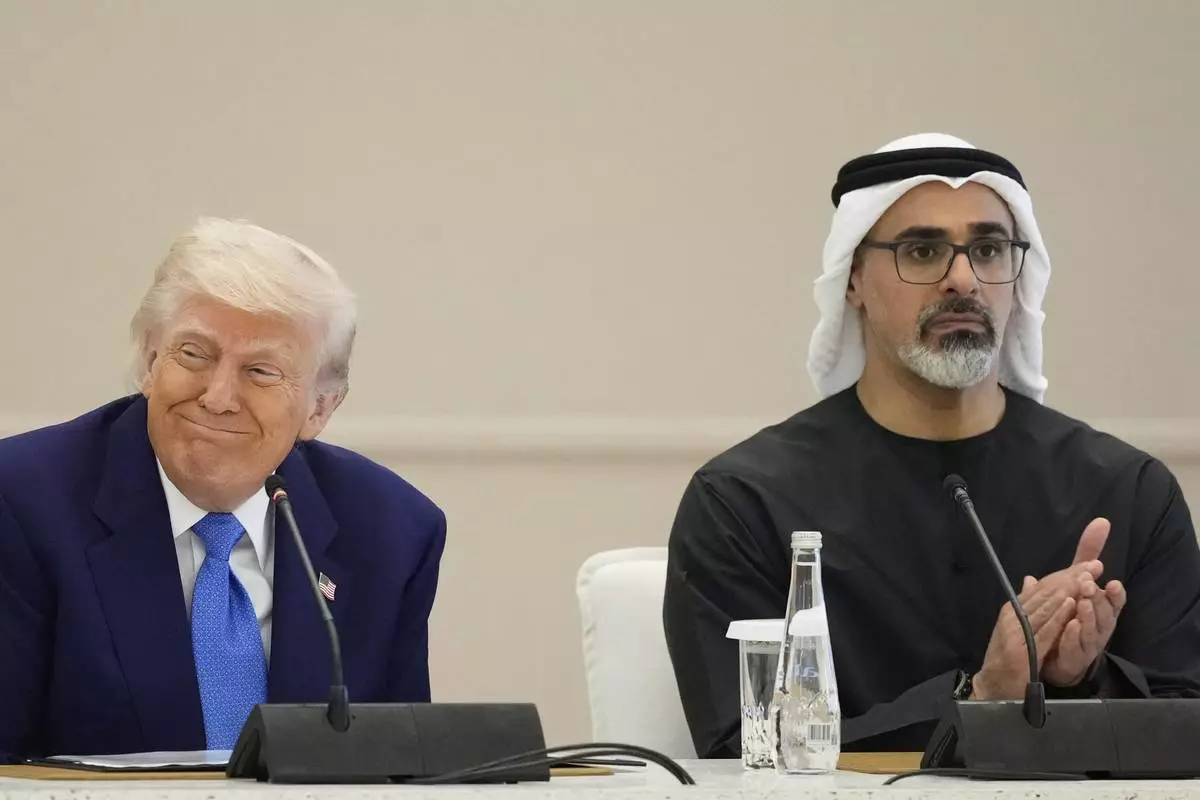
President Donald Trump and UAE President Mohammed bin Zayed Al Nahyan participate in a business roundtable at Qasr Al Watan, Friday, May 16, 2025, in Abu Dhabi, United Arab Emirates. (AP Photo/Alex Brandon)
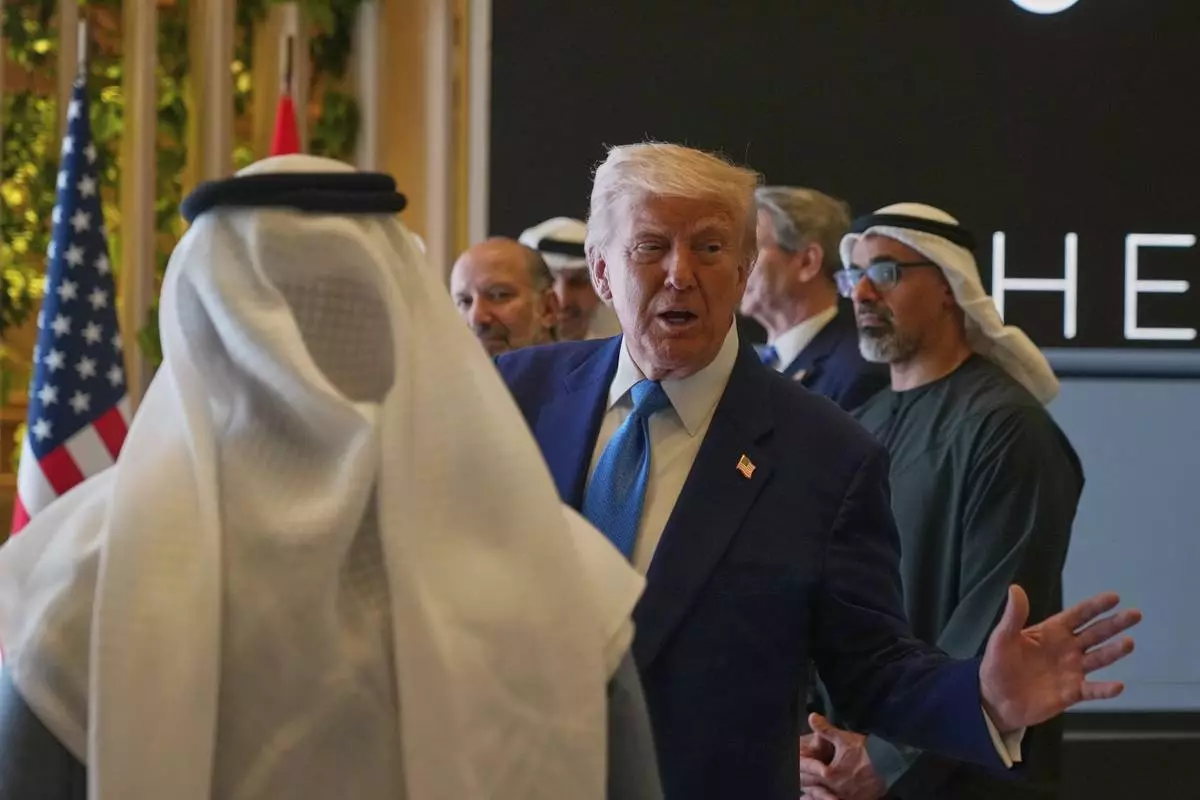
President Donald Trump attends a business meeting and roundtable at Qasr Al Watan, in Abu Dhabi, United Arab Emirates Friday, May 16, 2025. At right is Crown Prince of Abu Dhabi Sheikh Khaled Bin Mohamed Bin Zayed Al Nahyan.(AP Photo/Altaf Qadri)
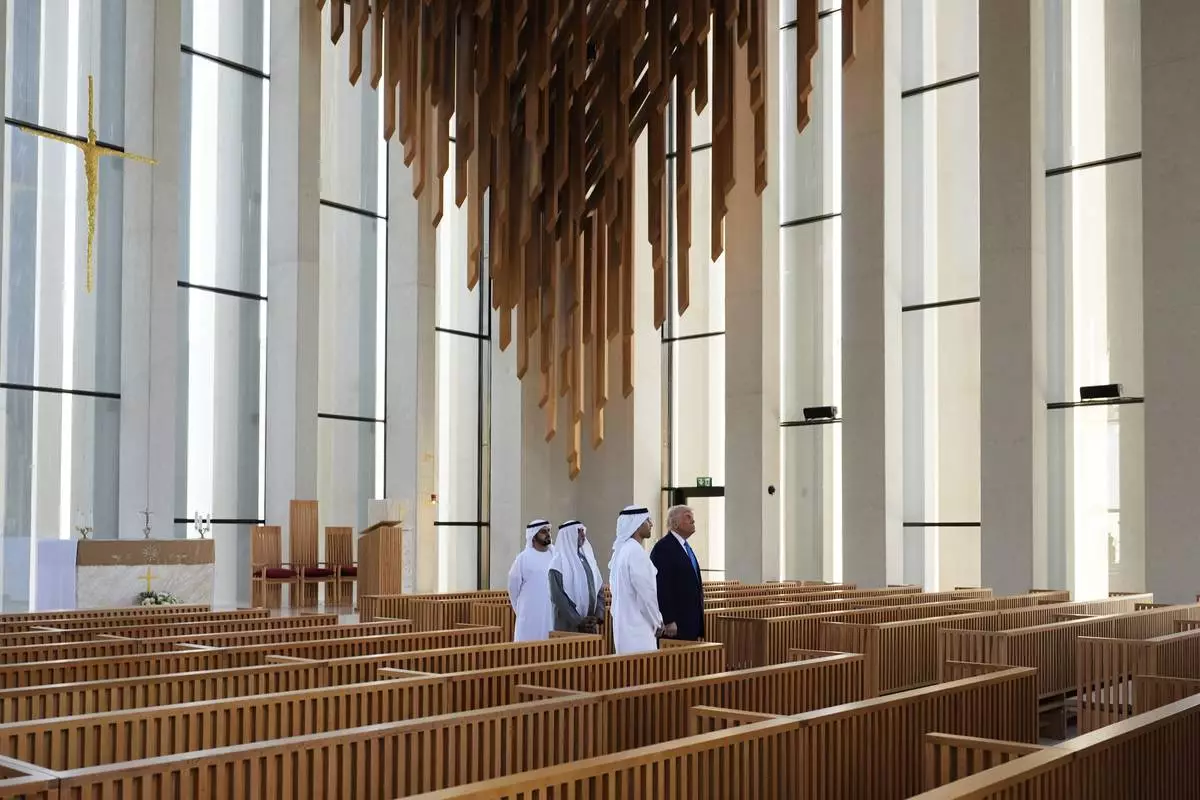
President Donald Trump tours the St. Francis Church at the Abrahamic Family House, Friday, May 16, 2025, in Abu Dhabi, United Arab Emirates. (AP Photo/Alex Brandon)

President Donald Trump and UAE President Mohammed bin Zayed Al Nahyan talk at Qasr Al Watan, Thursday, May 15, 2025, in Abu Dhabi, United Arab Emirates. (AP Photo/Alex Brandon)

President Donald Trump and UAE President Mohammed bin Zayed Al Nahyan arrive at Qasr Al Watan, Thursday, May 15, 2025, in Abu Dhabi, United Arab Emirates. (AP Photo/Alex Brandon)

President Donald Trump and Sheikh Khaled Mohammed bin Zayed Al Nahyan, Crown Prince of Abu Dhabi, right, tour the Sheikh Zayed Grand Mosque, Thursday, May 15, 2025, in Abu Dhabi, United Arab Emirates. (AP Photo/Alex Brandon)
